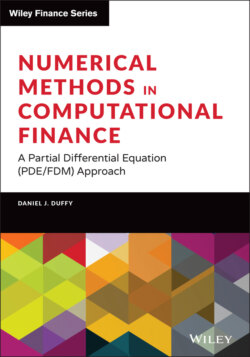Читать книгу Numerical Methods in Computational Finance - Daniel J. Duffy - Страница 38
2.3 DISCRETISATION OF INITIAL VALUE PROBLEMS: FUNDAMENTALS
ОглавлениеWe now discuss finding an approximate solution to Equation (2.1) using the finite difference method. We introduce several popular schemes as well as defining standardised notation.
The interval or range where the solution of Equation (2.1) is defined is . When approximating the solution using finite difference equations, we use a discrete set of points in where the discrete solution will be calculated. To this end, we divide into equal intervals of length , where is a positive number called the step size. (We also use the symbol to denote the step size in many cases.) We number these discrete points as shown in Figure 2.1. In general all coefficients and discrete functions will be defined at these mesh points only. We adopt the following notation:
Not only do we have to approximate functions at mesh points, but we also have to come up with a scheme to approximate the derivative appearing in Equation (2.1). There are several possibilities, and they are based on divided differences. For example, the following divided differences approximate the first derivative of at the mesh point ;
(2.8)
The first two divided differences are called one-sided differences and give first-order accuracy to the derivative, while the last divided difference is called a centred approximation to the derivative. In fact, by using a Taylor's expansion (assuming sufficient smoothness of ), we can prove the following:
FIGURE 2.1 Continuous and discrete spaces.
(2.9)
Note that the first two approximations use two consecutive mesh points while the last formula uses three consecutive mesh points.
We now decide on how to approximate Equation (2.1) using finite differences. To this end, we need to introduce two new concepts:
One-step and multistep methods
Explicit and implicit schemes.
A one-step method is a finite difference scheme that calculates the solution at time-level in terms of the solution at time-level . No information at levels , , or previous levels is needed in order to calculate the solution at level . A multistep method, on the other hand, is a difference scheme where the solution at level is determined by values at levels and possibly previous time levels. Multistep methods are more complicated than one-step methods, and we concentrate solely on the latter methods in this book.
An explicit difference scheme is one where the solution at time can be calculated from the information at level directly. No extra arithmetic is needed: for example, using division or matrix inversion. An implicit finite difference scheme is one in which the terms involving the approximate solution at level are grouped together and only then can the solution at this level be found. Obviously, implicit methods are more difficult to program than explicit methods because we must solve a system of equations at each time step.
